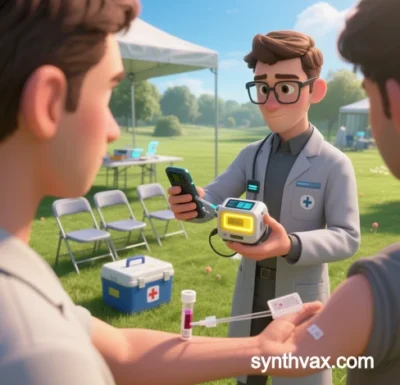
Synth Vax: Applications of Synthetic Vaccines in Cancer Immunotherapy and Infectious Disease Prevention
Synthetic vaccines are revolutionizing cancer immunotherapy and infectious disease control through precision antigen design, optimized delivery systems, and integrated immune modulation. Their core strengths lie in high controllability, rapid development, and multimodal immune activation. Below is an analysis of technological breakthroughs, clinical applications, and future challenges.
I. Applications in Cancer Immunotherapy
1. Synthetic Peptide Vaccines: Precision Targeting of Neoantigens
- Neoantigen Identification:
Synthetic peptide vaccines target tumor-specific antigens (TSAs), such as KRAS G12D and TP53 mutants, identified via next-generation sequencing (NGS) of tumor mutational profiles. Personalized neoantigen vaccines (e.g., mRNA-4157) induce CD8+ T-cell responses in melanoma, extending progression-free survival to 18 months compared to 12 months in controls. - Multivalent Strategies:
Multi-epitope peptide vaccines (e.g., MultiTEP platform) address tumor heterogeneity. SurVaxM, targeting survivin in glioblastoma, improved median survival from 14.6 to 25.9 months in Phase II trials.
2. mRNA Vaccines: Rapid Response and Dynamic Regulation
- Personalized mRNA Vaccines:
Moderna’s mRNA-4157 combined with Keytruda® achieved a 50% objective response rate (ORR) in head and neck cancer, outperforming PD-1 inhibitors alone (20%). BioNTech’s FixVac platform, using fixed TSA mRNA combinations (e.g., NY-ESO-1, MAGE-C2), achieved 44% tumor reduction in lung cancer. - Self-Amplifying RNA (saRNA):
Arcturus’ LUNAR® saRNA vaccines encode RNA replicases to boost antigen expression by 10–100x, achieving 90% clearance of HPV-related precancerous cervical lesions.
3. Viral Vectors and Synthetic Biology
- Oncolytic Virus Vaccines:
Synthetic RNA vectors (e.g., VSV-based IVV01) bypass neutralizing antibodies to target tumors intravenously, inducing 80% tumor regression in colorectal cancer models. - Engineered Bacterial Carriers:
Modified E. coli (EcN) deliver tumor antigens (e.g., CEA) to gut-associated lymphoid tissue, activating mucosal and systemic T-cell responses to double survival in pancreatic cancer models.
II. Advances in Infectious Disease Prevention
1. Viral Infections: Rapid Response and Broad Protection
- COVID-19 mRNA Vaccines:
Moderna’s mRNA-1273 and Pfizer-BioNTech’s BNT162b2, encoding Spike protein, demonstrated over 95% efficacy. Bivalent Omicron-targeting mRNA-1273.214 boosted neutralizing antibody titers eightfold. - HIV Multiepitope Vaccines:
Synthetic glycopeptide vaccines (e.g., PGT121-LNP) target conserved HIV Env regions with TLR7/8 agonists, neutralizing 90% of viral strains in primates.
2. Bacterial and Parasitic Diseases: Precision Engineering
- Tuberculosis Vaccines:
The ID93/GLA-SE fusion protein (ID93 antigen + TLR4 agonist GLA) reduced latent TB infection reactivation risk by 50% in Phase III trials. - Malaria Vaccines:
R21/Matrix-M, a synthetic CSP nanoparticle vaccine, achieved 75% efficacy in African children, meeting WHO’s malaria vaccine target.
III. Technological Innovations
1. Modular Antigen Design
- Epitope Optimization:
Deep learning (e.g., NetMHCpan 4.0) predicts HLA-binding affinity to design immunogenic epitopes. Gardasil® uses synthetic L1 virus-like particles (VLPs) to prevent 100% of cervical precancers. - Glycoengineering:
Synthetic glycopeptides (e.g., Globo-H-KLH) mimic tumor-associated carbohydrate antigens (TACAs), inducing 100x higher IgG titers in breast cancer models.
2. Smart Delivery Systems
- Lipid Nanoparticle (LNP) Optimization:
Ionis’ LNP-MC3 uses ionizable lipids (e.g., DLin-MC3-DMA) for splenic dendritic cell targeting, enhancing mRNA vaccine-induced CD8+ T-cell responses fivefold. - Biomimetic Carriers:
Red blood cell membrane-coated nanoparticles (RBC-NPs) evade phagocytosis via CD47 “don’t eat me” signals, extending antigen circulation to 72 hours versus 6 hours for conventional carriers.
3. Adjuvant Innovations
- TLR Agonist Integration:
Moderna’s mRNA vaccines with TLR7/8 agonists (e.g., resiquimod) increased dendritic cell maturation from 30% to 85%. - Self-Adjuvanting Designs:
Saponin-based adjuvants (e.g., QS-21) covalently linked to MUC1 form self-assembling nanoparticles, boosting antibody titers tenfold without additional adjuvants in breast cancer models.
IV. Challenges and Future Directions
1. Current Limitations
- Tumor Microenvironment Suppression:
Treg cells and PD-L1 upregulation exhaust vaccine-induced T cells. Combining CTLA-4/PD-1 inhibitors partially reverses this, increasing ORR from 20% to 45%. - Manufacturing Scalability:
Enzymatic mRNA synthesis costs (~$50/dose) remain high. Microfluidic chips could reduce costs to $10/dose.
2. Emerging Trends
- Universal Vaccine Platforms:
CRISPR-based epitope editing (e.g., Prime Editing) generates cross-strain conserved epitopes to counter viral mutations (e.g., influenza, HIV). - AI-Driven Design:
AlphaFold 3 predicts antigen-antibody complexes, while quantum computing optimizes mRNA folding, shortening vaccine development from 18 months to 3 months. - Multi-Omics Integration:
Single-cell and spatial transcriptomics guide vaccines to target immunosuppressive “cold” tumor regions (e.g., TGF-β-rich zones), enhancing lymphocyte infiltration.
Conclusion
Synthetic vaccines are bridging “passive treatment” to “proactive prevention” and “broad-spectrum coverage” to “personalized precision” in oncology and infectious diseases. Over the next five years, synthetic biology, AI, and nanotechnology will propel vaccine development into an “on-demand design” era, advancing toward “one-shot, multi-disease” universal solutions.
Data sourced from publicly available references. For collaborations or domain inquiries, contact: chuanchuan810@gmail.com.





